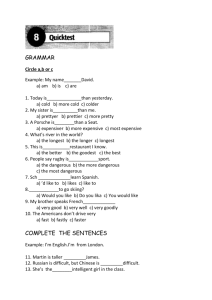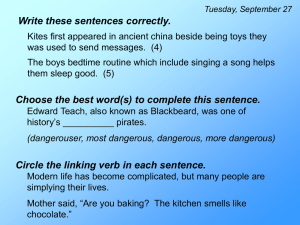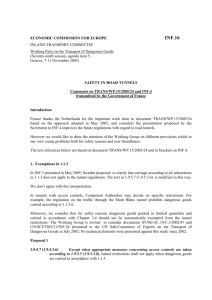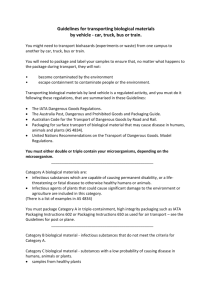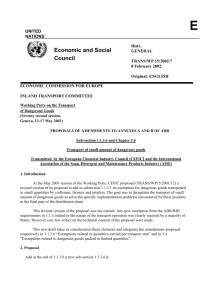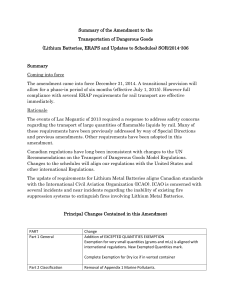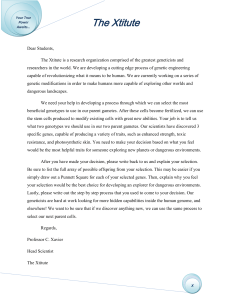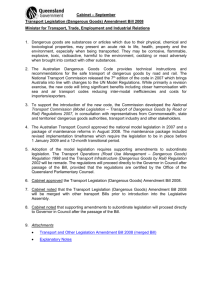United Nations
advertisement
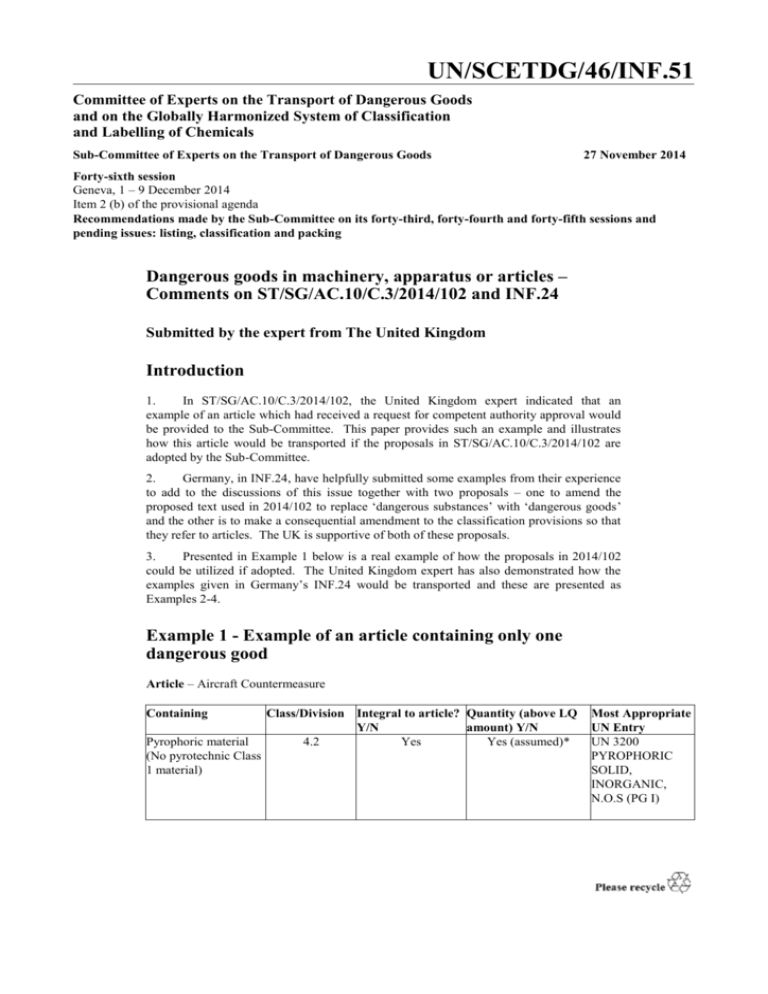
UN/SCETDG/46/INF.51 Committee of Experts on the Transport of Dangerous Goods and on the Globally Harmonized System of Classification and Labelling of Chemicals Sub-Committee of Experts on the Transport of Dangerous Goods 27 November 2014 Forty-sixth session Geneva, 1 – 9 December 2014 Item 2 (b) of the provisional agenda Recommendations made by the Sub-Committee on its forty-third, forty-fourth and forty-fifth sessions and pending issues: listing, classification and packing Dangerous goods in machinery, apparatus or articles – Comments on ST/SG/AC.10/C.3/2014/102 and INF.24 Submitted by the expert from The United Kingdom Introduction 1. In ST/SG/AC.10/C.3/2014/102, the United Kingdom expert indicated that an example of an article which had received a request for competent authority approval would be provided to the Sub-Committee. This paper provides such an example and illustrates how this article would be transported if the proposals in ST/SG/AC.10/C.3/2014/102 are adopted by the Sub-Committee. 2. Germany, in INF.24, have helpfully submitted some examples from their experience to add to the discussions of this issue together with two proposals – one to amend the proposed text used in 2014/102 to replace ‘dangerous substances’ with ‘dangerous goods’ and the other is to make a consequential amendment to the classification provisions so that they refer to articles. The UK is supportive of both of these proposals. 3. Presented in Example 1 below is a real example of how the proposals in 2014/102 could be utilized if adopted. The United Kingdom expert has also demonstrated how the examples given in Germany’s INF.24 would be transported and these are presented as Examples 2-4. Example 1 - Example of an article containing only one dangerous good Article – Aircraft Countermeasure Containing Pyrophoric material (No pyrotechnic Class 1 material) Class/Division Integral to article? Quantity (above LQ Y/N amount) Y/N 4.2 Yes Yes (assumed)* Most Appropriate UN Entry UN 3200 PYROPHORIC SOLID, INORGANIC, N.O.S (PG I) UN/SCETDG/46/INF.51 *Quantity – Unknown. Assumed to be in excess of limited quantity provisions. As UN3200 is not permitted in limited quantities or excepted quantities, the article cannot utilize the proposed exemption in 1.1.1.10 or the existing UN3363 entry. Classification according to 2014/102 UN Number: UN 35XZ Proper Shipping Name: DANGEROUS GOODS IN ARTICLES, N.O.S Class/Division: 4.2 Label(s): 4.2 Packaging – In accordance with P003 Documentation – Dangerous Goods Description on the transport document as follows: UN 35XZ, DANGEROUS GOODS IN ARTICLES, N.O.S, (pyrophoric solid, inorganic, n.o.s), 4.2 Example 2 – Example of an article containing multiple dangerous goods including other articles (see first example in INF.24) Article – Kitchen Container Cooking (ZuCon) 8,5 Containing cleaning agent disinfectant oven cleaner 8 Yes No (4 l in total) 2.2 Yes Yes* Cleaning agent 3 Yes No** RM 33 8 Yes Yes 2.2 Yes Yes* Fire extinguisher Fire extinguisher 2 Class/Division Integral to article? Quantity (above LQ Y/N amount) Y/N 5.2 Yes No (400g in total) Appropriate UN Entry UN 3108, ORGANIC PEROXIDE TYPE E, SOLID (LQ, no PG) UN 1824, SODIUM HYDROXIDE SOLUTION (LQ, PG III) UN 1044, FIRE EXTINGUISHERS, with compressed or liquefied gas (LQ, no PG) UN 1987, ALCOHOLS, N.O.S. (LQ, PG II or PG III) UN1824, SODIUM HYDROXIDE SOLUTION (LQ, PG II) UN 1044, FIRE EXTINGUISHERS, with compressed or liquefied gas (LQ, no PG) UN/SCETDG/46/INF.51 4 batteries 8 Yes N/A due to exemption UN 2800 in SP238 BATTERIES, WET, NONSPILLABLE, electric storage (LQ, no PG) (exempted SP238) * Quantity – Unknown. Assumed to be in excess of limited quantity provisions. ** If either PG II or III, 1 litre of this substance would not be in excess of the LQ provisions for this substance. Classification according to 2014/102 Example 2 provides an interesting scenario. Not all of the dangerous goods contained within this article are in quantities in excess of limited quantities; some of the dangerous goods are exempt from the Model Regulations due to other provisions and some are articles themselves. The question remains as to how to transport this article. As not all of the dangerous goods are being transported in quantities permitted by limited quantity provisions, it seems clear that application of UN 3363 and assignment to Class 9 is not permitted. Therefore allocation to one of the new UN entries for Dangerous Goods in Articles is appropriate. The United Kingdom expert believes that as the text of SPXXX states that it is the Precedence of Hazards section in 2.0.3 which determines the primary risk present regardless of the quantities of each, all the dangerous goods present should be considered together. It does not appear to be appropriate to consider dangerous goods which would otherwise be exempt from the regulations. To this end, the following classification would be the result of the application of the proposals in 2014/102: Note – For this classification an assumption is made that the Class 3 cleaning agent is packing group III. UN Number: UN 35XX Proper Shipping Name: DANGEROUS GOODS IN ARTICLES, N.O.S Class/Division: 2.2 Subsidiary Risks: 5.2 and 8 Label(s): 2.2, 5.2 and 8 Packaging – Due to the size of the article, the final paragraph of packaging instruction P003 applies. This means that competent authority approval would need to be obtained as specified in 4.1.3.8.1 and 4.1.3.8.2. Documentation – Dangerous Goods Description on the transport document as follows: UN 35XX, DANGEROUS GOODS IN ARTICLES, N.O.S, (fire extinguishers, with compressed or liquefied gas), 2.2 (5.2, 8) 3 UN/SCETDG/46/INF.51 Example 3 – Example of an article containing multiple dangerous goods (see second example in INF.24) Article – Kitchen Container Preparation (VorCon) 8,5-2 Containing cleaning agent 33 Class/Division Integral to article? Quantity (above LQ Y/N amount) Y/N 8 Yes Yes Reiniger Geschirr (dishwasher cleaner) 8 Yes RM Desinfektionsmittel (disinfectant) 5.2 Yes 8 Yes 2 batteries Appropriate UN Entry UN 1824, SODIUM HYDROXIDE SOLUTION (LQ, PG II) Yes UN 3266, CORROSIVE LIQUID, BASIC, INORGANIC (LQ, PG II) No (400g in total) UN 3108 ORGANIC PEROXIDE TYPE E, SOLID (LQ, no PG) N/A due to exemption UN 2800 in SP238 BATTERIES, WET, NONSPILLABLE, electric storage (LQ, no PG) (exempted SP238) Classification according to 2014/102 Similar to Example 2, the example above contains dangerous goods (batteries) which would otherwise be exempt from the regulations. As mentioned previously it would not be logical to include them in the consideration of what the primary hazard is for this article. Example 3 also contains a substance which is not being transported in quantities exceeding the limited quantities threshold, but as it is within an article which also contains dangerous goods in quantities exceeding limited quantity thresholds it is again clear that application of UN 3363 and assignment to Class 9 is not permitted for this article. The following classification would be the result of the application of the proposals in 2014/102: UN Number: UN 35YX Proper Shipping Name: DANGEROUS GOODS IN ARTICLES, N.O.S Class/Division: 5.2 Subsidiary Risk: 8 Label(s): 5.2 and 8 Packaging – Due to the size of the article, the final paragraph of packaging instruction P003 applies. This means that competent authority approval would need to be obtained as specified in 4.1.3.8.1 and 4.1.3.8.2. 4 UN/SCETDG/46/INF.51 Documentation – Dangerous Goods Description on the transport document as follows: UN 35YX, DANGEROUS GOODS IN ARTICLES, N.O.S, (organic peroxide type E, solid), 5.2 (8) Example 4 – Example of an article containing another article already listed in the Dangerous Goods List (see third example in INF.24) Article – Kitchen Container Convenience Food (ConvenCon) 8,5 Containing Class/Division Integral to article? Quantity (above LQ Y/N amount) Y/N 2.2 Yes Yes* Appropriate UN Entry Fire extinguisher UN 1044, FIRE EXTINGUISHERS, with compressed or liquefied gas (LQ, no PG) 2 batteries 8 Yes N/A due to exemption UN 2800 in SP238 BATTERIES, WET, NONSPILLABLE, electric storage (LQ, no PG) (exempted SP238) *Quantity – Unknown. Assumed to be in excess of limited quantity provisions. Classification according to 2014/102 Example 4 is of an article containing another article plus dangerous goods which are already exempt from the regulations (batteries). As the presumption is that the fire extinguishers are being transported in excess of the limited quantity provision of 120ml, allocation to one of the new UN entries for Dangerous Goods in Articles is appropriate. UN Number: UN 35XX Proper Shipping Name: DANGEROUS GOODS IN ARTICLES, N.O.S Class/Division: 2.2 Subsidiary Risk: Label(s): 2.2 Packaging – Due to the size of the article, the final paragraph of packaging instruction P003 applies as with the other examples from INF.24. This means that competent authority approval would need to be obtained as specified in 4.1.3.8.1 and 4.1.3.8.2. Documentation – Dangerous Goods Description on the transport document as follows: UN 35XX, DANGEROUS GOODS IN ARTICLES, N.O.S, (fire extinguishers, with compressed or liquefied gas), 2.2 5
